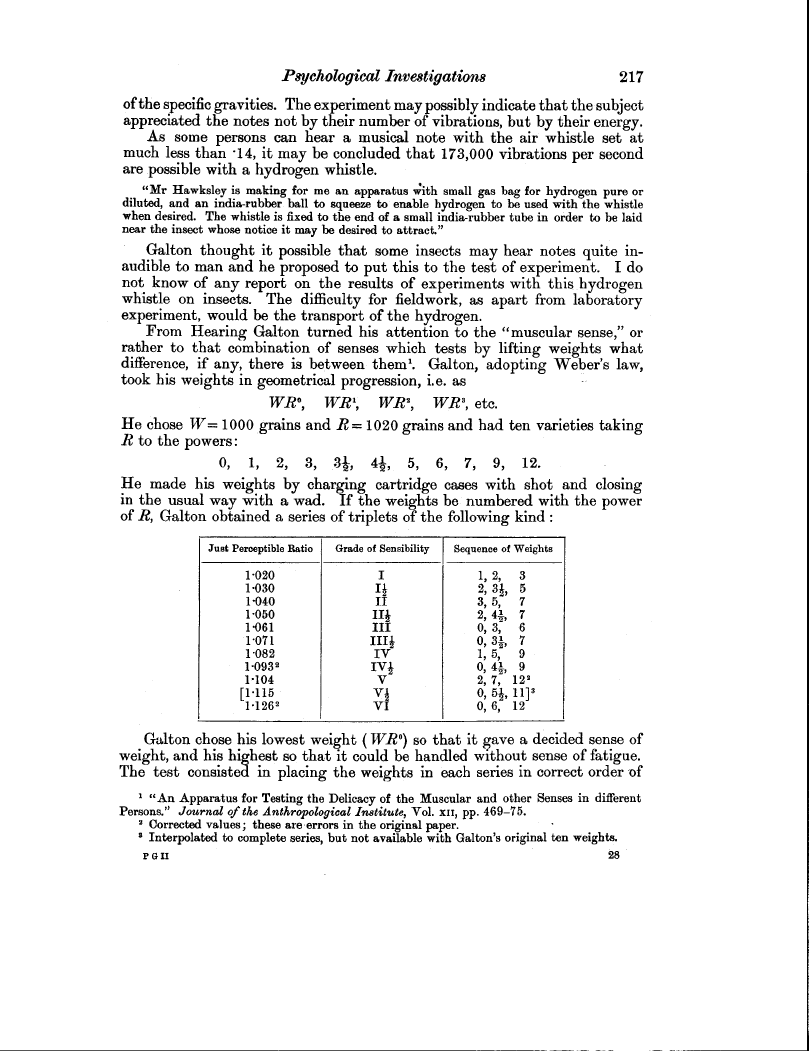Psychological Investigations 217
of the specific gravities. The experiment may possibly indicate that the subject appreciated the notes not by their number of vibrations, but by their energy.
As some persons can hear a musical note with the air whistle set at much less than •14, it may be concluded that 173,000 vibrations per second are possible with a hydrogen whistle.
"Mr Hawksley is making for me an apparatus with small gas bag for hydrogen pure or diluted, and an india-rubber ball to squeeze to enable hydrogen to be used with the whistle when desired. The whistle is fixed to the end of a small india-rubber tube in order to be laid near the insect whose notice it may be desired to attract."
Galton thought it possible that some insects may hear notes quite inaudible to man and he proposed to put this to the test of experiment. I do not know of any report on the results of experiments with this hydrogen whistle on insects. The difficulty for fieldwork, as apart from laboratory experiment, would be the transport of the hydrogen.
From Hearing Galton turned his attention to the "muscular sense," or rather to that combination of senses which tests by lifting weights what difference, if any, there is between them'. Galton, adopting Weber's law, took his weights in geometrical progression, i.e. as
WR°, WR', YVR', WR', etc.
He chose W= 1000 grains and R=1020 grains and had ten varieties taking R to the powers:
0, 1, 2, 3, 31, 41, 5, 6, 7, 9, 12.
He made his weights by charging cartridge cases with shot and closing in the usual way with a wad. If the weights be numbered with the power of R, Galton obtained a series of triplets of the following kind
|
Just Perceptible Ratio |
Grade of Sensibility |
Sequence |
|
of |
|
Weights |
|
1-020 |
|
I |
|
1, |
2, |
3 |
|
|
1.030 |
|
Ii |
|
2, |
31, |
5 |
|
|
1.040 |
|
II |
|
3, |
5, |
7 |
|
|
1.050 |
|
III |
|
2, |
41 , |
7 |
|
|
1.061 |
|
III |
|
0, |
3, |
6 |
|
|
1.071 |
|
1111 |
|
0, |
32, |
7 |
|
|
1.082 |
|
IV |
|
1, |
5, |
9 |
|
|
1.0932 |
|
IV- |
|
0, |
4-, |
9 |
|
|
1.104 |
|
V |
|
2, |
7, |
12 |
2 |
|
[1-115 |
|
VA |
|
0, 5j, 11]3 |
|
1.1262 |
|
VI |
|
0, 6, 12 |
Galton chose his lowest weight (WR°) so that it gave a decided sense of weight, and his highest so that it could be handled without sense of fatigue. The test consisted in placing the weights in each series in correct order of
I "An Apparatus for Testing the Delicacy of the Muscular and other Senses in different
Persons." Journal of the Anthropological Institute, Vol. xii, pp. 469-75.
2 Corrected values; these are errors in the original paper.
8 Interpolated to complete series, but not available with Galton's original ten weights.
P G 11 28

